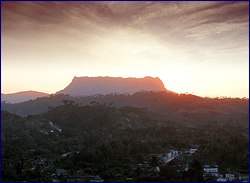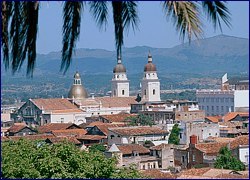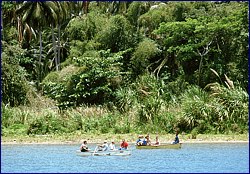 |
 |

The Tropic's Green Lusta
Abundant tropical forests in the northern part of Cuba’s “far east” are surrounded by imposing mountains where coffee and cocoa grow. The southern strip of Guantánamo province along the Caribbean is semi-arid desert. And on the farthest tip is the US military base at Guantánamo Bay.
Sugar cane grows in Guantánamo's valleys and plains while on the green mountains coffee and cocoa plantations predominate. The dry south is home to Cuba's largest salt works. The village of Baracoa, the first settlement founded by Spanish conquistadors in 1511, is replete with natural and historic curiosities recently rediscovered after more than four centuries of isolation.
Unique music lends a refreshing tone to this area as well. The soft changüí, which uses no electrical instruments, is a favourite dance rhythm in villages such as Virginia and Yateras. The Tumba Francesa is a Creole dance inspired by the minuet and other French aristocratic dances brought to the island by slaves and French slave owners in the 18th century. These dances took root here and in Santiago de Cuba.

| Places to visit |
![]() Alexander Von Humboldt National Park
Alexander Von Humboldt National Park
Straddling the provinces of Guantánamo and Holguín, this is the best preserved mountainous ecosystem in the Caribbean. The park is a treasure trove of indigenous Antillean and Cuban flora and fauna.
![]() The Toa's Challenges
The Toa's Challenges
Cuba's widest river springs up on Guantánamo's mountains and jungle and ends near Baracoa. The river can be navigated in cayucos (punts) or rafts.
![]() The Parra Cross
The Parra Cross
Found near Baracoa, this ancient cross is reputed to be the only material evidence of Columbus' presence here in 1492.
![]() Maguana Beach
Maguana Beach
Protected by a coral reef, this white-sand beach is a few miles from Baracoa.
![]() Cactus garden
Cactus garden
Some 2,000 cacti grow in this huge garden in the semi-arid southern region along the Guantánamo-Baracoa highway.
![]() La Farola
La Farola
Highway winds deep into the mountains near Cajobabo, the beach where National Hero José Martí disembarked in 1895. The road has 11 bridges suspended over the abyss.
![]() Yateras Stone Zoo
Yateras Stone Zoo
Images of humans and wild animals are carved in the rocks here by a local artist.
![]() Malone Lookout Point
Malone Lookout Point
This lookout offers an expansive view of the Guantanamo Naval Base at the mouth of Guantánamo Bay.
 18.24°C
18.24°C




